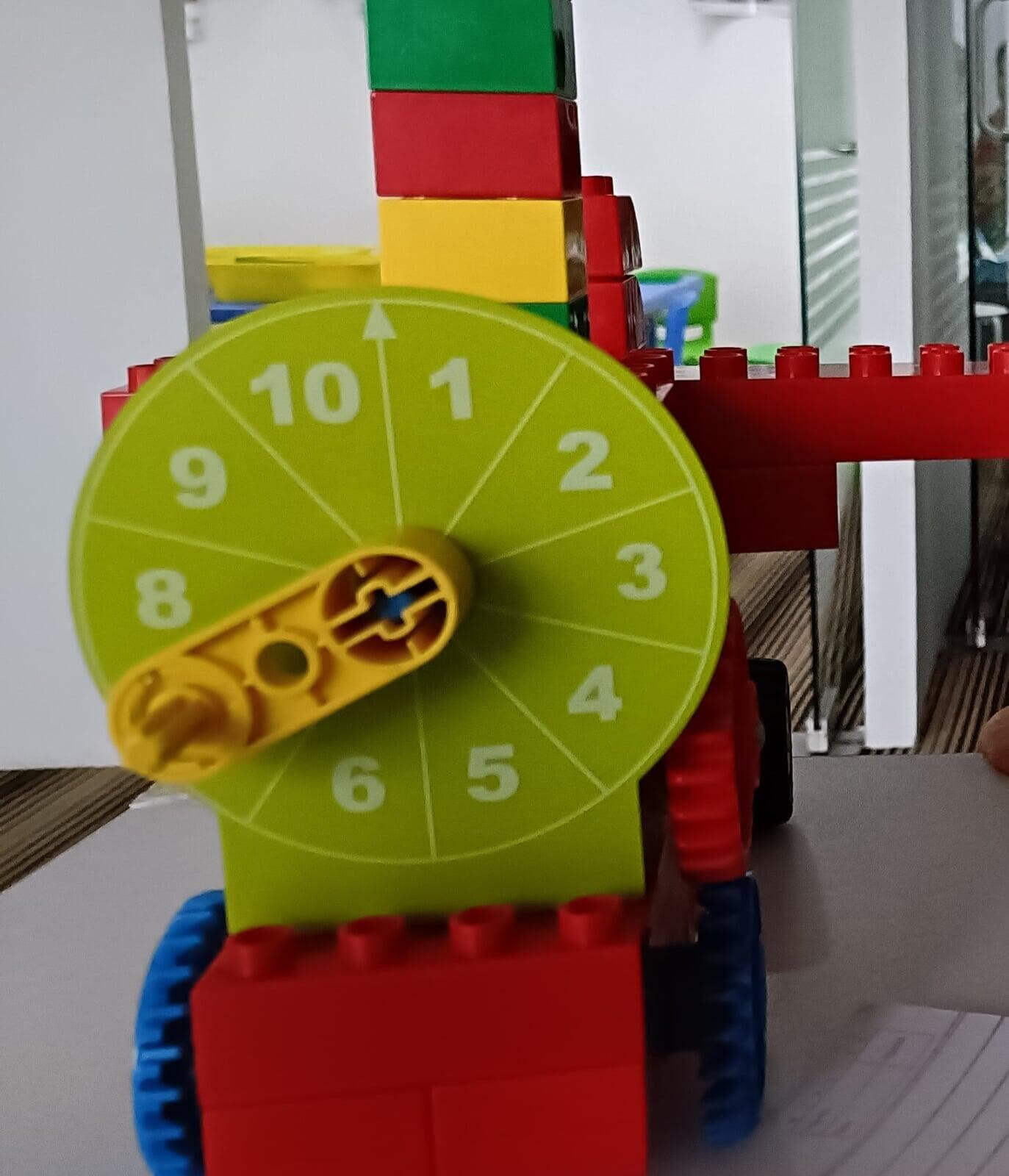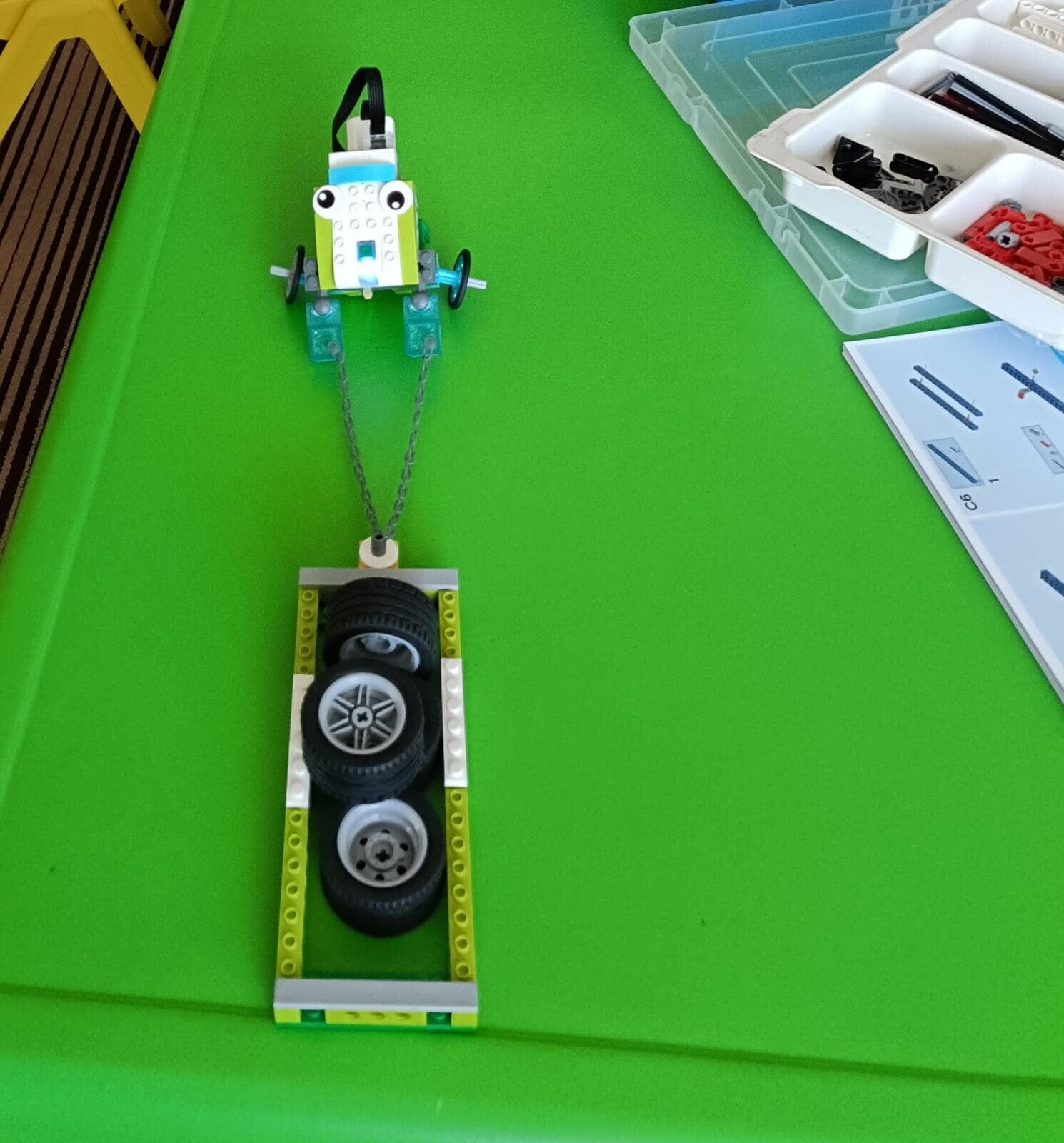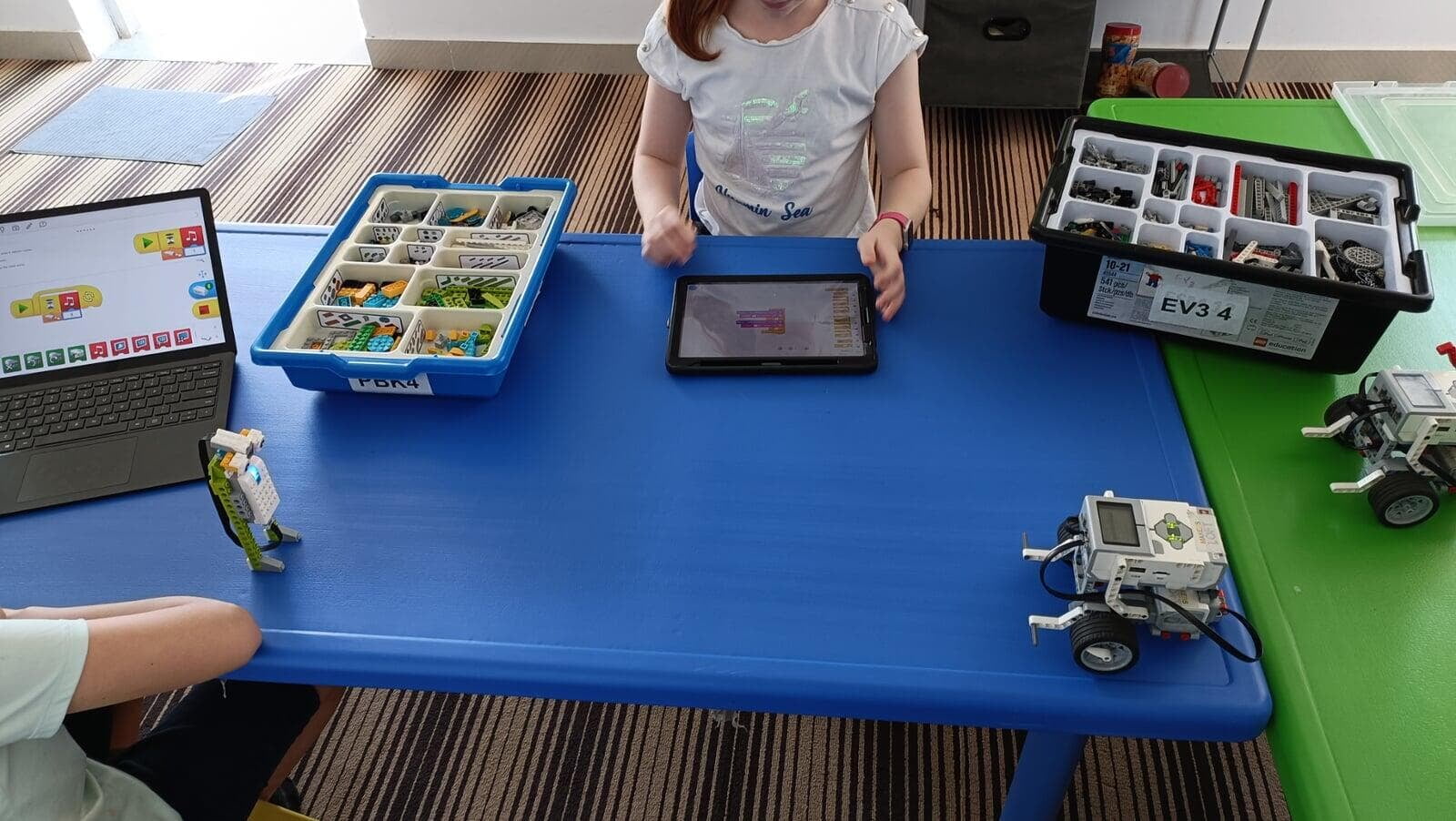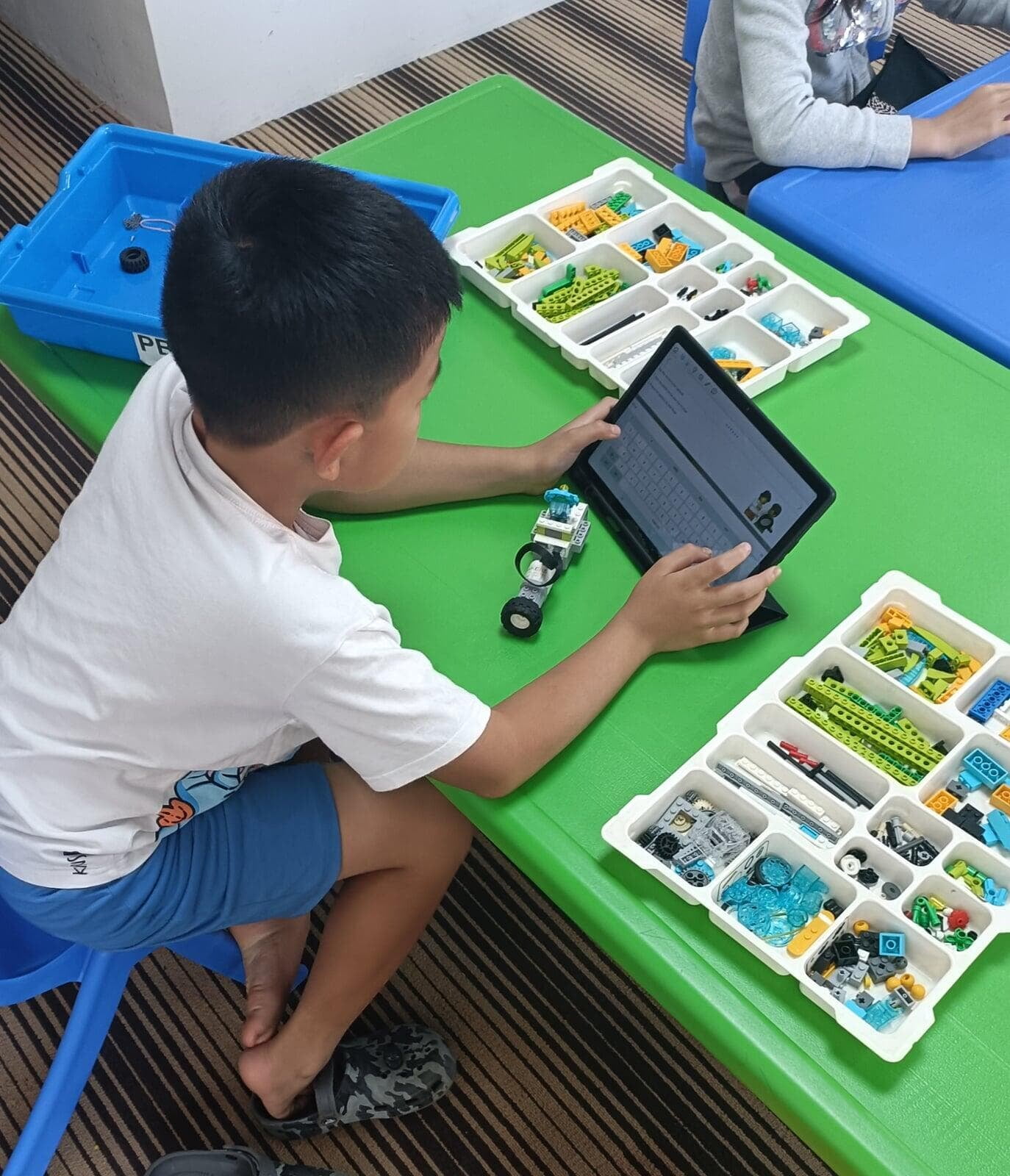Through robotics, children learn a variety of math concepts in an engaging, practical way. Some of the key math concepts they encounter include:
1. Geometry:
Shapes and Angles: Designing robots and programming their movements involves understanding basic shapes (squares, circles, triangles) and angles. For instance, robots often need to turn a certain number of degrees (like 90° for a right turn) or move in a geometric path.
Spatial Reasoning: Kids develop spatial awareness by planning how their robot will move in 3D space and considering how different parts fit and move together.

2. Algebra:Variables and Equations: Programming a robot often involves using variables to represent different values (like speed, distance, or time). Children learn to solve simple equations and use algebraic thinking to adjust robot behaviors.
Linear Relationships: Kids explore relationships like distance = speed × time, which helps them understand the concept of rate and proportional reasoning in real-world scenarios.
3. Measurement:Length, Distance, and Time: Robotics challenges often require students to measure distances, estimate time intervals, or calculate how long a robot needs to move or turn. This enhances their understanding of units of measurement (meters, seconds, degrees).
Area and Perimeter: In tasks involving robot navigation, students might need to calculate the area a robot will cover or the perimeter of a space it will navigate.
2. Algebra:
Variables and Equations: Programming a robot often involves using variables to represent different values (like speed, distance, or time). Children learn to solve simple equations and use algebraic thinking to adjust robot behaviors.
Linear Relationships: Kids explore relationships like distance = speed × time, which helps them understand the concept of rate and proportional reasoning in real-world scenarios.
3. Measurement:
Length, Distance, and Time: Robotics challenges often require students to measure distances, estimate time intervals, or calculate how long a robot needs to move or turn. This enhances their understanding of units of measurement (meters, seconds, degrees).
Area and Perimeter: In tasks involving robot navigation, students might need to calculate the area a robot will cover or the perimeter of a space it will navigate.
4. Ratios and Proportions:Gear Ratios: When using gears to control robot movement, kids learn about ratios by understanding how different gear sizes affect speed and torque. This teaches them proportional reasoning as they adjust these components.
Proportional Relationships: Adjusting motor speed or power involves working with proportions, such as how halving the speed will affect the distance traveled or time taken.
5. Statistics and Data Analysis:Data Collection and Graphing: Robots often use sensors to collect data (e.g., distance, light, temperature). Kids can analyze this data, make graphs, and interpret trends, reinforcing statistical concepts like mean, range, and variance.
Probability: In some robotics challenges, kids use probability to make decisions or predictions based on sensor input or environmental variables.
4. Ratios and Proportions:
Gear Ratios: When using gears to control robot movement, kids learn about ratios by understanding how different gear sizes affect speed and torque. This teaches them proportional reasoning as they adjust these components.
Proportional Relationships: Adjusting motor speed or power involves working with proportions, such as how halving the speed will affect the distance traveled or time taken.
5. Statistics and Data Analysis:
Data Collection and Graphing: Robots often use sensors to collect data (e.g., distance, light, temperature). Kids can analyze this data, make graphs, and interpret trends, reinforcing statistical concepts like mean, range, and variance.
Probability: In some robotics challenges, kids use probability to make decisions or predictions based on sensor input or environmental variables.


6. Fractions and Decimals:Division of Movements: Programming a robot to move or turn a fraction of a full rotation (e.g., half-turns, quarter-turns) introduces fractions and decimals. Adjusting power or speed to specific percentages (e.g., 50% of full speed) requires understanding of decimals.
Part-to-Whole Relationships: Dividing tasks into smaller steps or calculating partial distances helps kids apply fractional thinking.
7. Patterns and Sequences:Repeating Commands: Programming robots often involves creating loops or repeated actions, which helps kids recognize and work with patterns. Sequencing these actions also introduces them to logical, ordered thinking, which is a foundation for understanding number patterns and sequences in math.
6. Fractions and Decimals:
Division of Movements: Programming a robot to move or turn a fraction of a full rotation (e.g., half-turns, quarter-turns) introduces fractions and decimals. Adjusting power or speed to specific percentages (e.g., 50% of full speed) requires understanding of decimals.
Part-to-Whole Relationships: Dividing tasks into smaller steps or calculating partial distances helps kids apply fractional thinking.
7. Patterns and Sequences:
Repeating Commands: Programming robots often involves creating loops or repeated actions, which helps kids recognize and work with patterns. Sequencing these actions also introduces them to logical, ordered thinking, which is a foundation for understanding number patterns and sequences in math.
8. Logical Reasoning and Boolean Algebra:If-Then Statements: Programming robots to respond to conditions (e.g., "if the sensor detects an obstacle, then turn left") introduces Boolean logic and decision-making. This kind of logic helps students understand how computers and algorithms work.
Truth Tables and Logic Gates: Advanced robotics programs may introduce kids to logic gates (AND, OR, NOT), helping them explore the mathematical foundation of computing and circuits.
9. Problem-Solving with Equations:Speed, Distance, and Time: Robotics activities that involve calculating how long or fast a robot should move help kids understand formulas like distance = speed × time, reinforcing algebraic concepts and equations.
8. Logical Reasoning and Boolean Algebra:
If-Then Statements: Programming robots to respond to conditions (e.g., "if the sensor detects an obstacle, then turn left") introduces Boolean logic and decision-making. This kind of logic helps students understand how computers and algorithms work.
Truth Tables and Logic Gates: Advanced robotics programs may introduce kids to logic gates (AND, OR, NOT), helping them explore the mathematical foundation of computing and circuits.
9. Problem-Solving with Equations:
Speed, Distance, and Time: Robotics activities that involve calculating how long or fast a robot should move help kids understand formulas like distance = speed × time, reinforcing algebraic concepts and equations.

10. Coordinate Geometry:Positioning and Navigation: When programming robots to move in specific directions or to specific coordinates, students learn about the Cartesian plane, x and y axes, and how to navigate through grid-like systems.
11. Angle Measurements:Rotation and Turns: Programming robots to turn specific angles (e.g., 90°, 180°) helps kids understand degrees and angular movement. They also learn to calculate total rotations or divide circles into equal parts, reinforcing angle-related geometry concepts.
Through robotics, these math concepts become more than just abstract ideas—they become part of the child’s toolkit for solving real-world challenges, making math more tangible, practical, and engaging.
10. Coordinate Geometry:
Positioning and Navigation: When programming robots to move in specific directions or to specific coordinates, students learn about the Cartesian plane, x and y axes, and how to navigate through grid-like systems.
11. Angle Measurements:
Rotation and Turns: Programming robots to turn specific angles (e.g., 90°, 180°) helps kids understand degrees and angular movement. They also learn to calculate total rotations or divide circles into equal parts, reinforcing angle-related geometry concepts.
Through robotics, these math concepts become more than just abstract ideas—they become part of the child’s toolkit for solving real-world challenges, making math more tangible, practical, and engaging.
